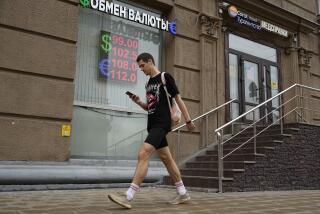Changing Lifestyles : Countries Flee ‘Ruble Zone’ for Uncharted Territory : Across the former Soviet Union, new currencies emerge as a symbol of sovereignty and faith in the free market.
- Share via
MOSCOW — Lithuania, the defiant little Baltic state that was first to declare independence from the Soviet Union, introduced a new currency last month. Faced with triple-digit inflation and low treasury reserves, the lita is in for a rough ride.
But Lithuanians are hopeful that the lita will fare better than two national heroes portrayed on its bank notes. Pioneer aviators, they crossed the Atlantic from New York in 1933, only to be shot down over Nazi Germany when they apparently strayed too near a military base.
Across a broken empire once ruled by Communists and their rubles, new currencies are emerging as symbols of sovereignty and faith in the free market. For ex-Soviet republics, the act of leaving what is now Russia’s “ruble zone” is a rite of passage, a flight into the unknown.
Nearly two years after the Soviet Union collapsed, five of the 14 newly independent states on Russia’s perimeter have launched their own currencies--Ukraine, the Baltic states of Estonia, Latvia and Lithuania, and the Central Asian republic of Kyrgyzstan--with mixed results.
Their colorful array of bills--karbovanets, kroons, lats, litas and soms, emblazoned with national emblems and portraits of unsung heroes--is a vivid sign of the disintegration of a region whose economies are still closely linked.
Last month, Moscow sped up this process by invalidating all ruble bills printed before 1993 for Russia and the nine other countries still using them. This was meant, in part, to seal off Russia from ruble inflation created by its neighbors.
The abrupt measure, which created turmoil in banks and marketplaces throughout most of the former Soviet Union, in effect gives Russia its own exclusive currency. It will force the other ruble nations either to launch their own currencies or to adopt the new Russian ruble along with increasingly stringent monetary policies dictated by the Central Bank in Moscow.
“The old ruble zone ended its existence on July 26,” Andrei I. Kazmin, Russia’s deputy finance minister, said in an interview. “The situation that existed before then could not have lasted forever.”
Since then, Azerbaijan, Georgia, Moldova and Turkmenistan have announced plans to join those countries that have dropped the ruble and to mint their own currencies.
The rest face a choice between shaky financial independence and the mixed blessing of freer trade with Russia, along with its relatively high inflation.
Both options are bleak. Living standards have fallen in all 15 ex-Soviet republics over the last two years, and popular cynicism over the benefits of freedom has rubbed off on the ruble and its substitutes. Georgia’s temporary coupons, for example, are dubbed fantiki, or candy wrappers.
Ukraine and the Baltics made early decisions to mint their own money largely for political reasons--to abolish the ruble as a hated token of Moscow’s “occupation.”
The Baltics began plotting new currencies as early as 1990. Some Estonians revered the kroon so much that they bought new wallets to carry the bills. Latvia’s lats went into circulation ahead of schedule in part to boost the government’s patriotic image before parliamentary elections in June.
Estonia and Latvia, along with Kyrgyzstan, had another reason to ditch the ruble--to protect their free-market reforms and strict monetary discipline from ruble inflation, which runs as high as 20% a month in Russia.
Ukraine, on the other hand, staked out the freedom to run a looser monetary policy than Russia’s. Battered by runaway public spending, Ukraine’s karbovanets quickly gained infamy as a currency even weaker than the ruble.
Until last week, staying in the ruble zone offered each member state an incentive to outspend the others and stick them with part of the bill. They simply bought goods elsewhere, mostly in Russia, and issued new ruble credits to pay; the resulting inflation spread across the entire zone.
Russia, with a trade surplus in the ruble zone, was the big loser in that game. Officials estimate that it transferred $17 billion in what amounts to trade subsidies to neighboring republics last year--as much as Russia received in Western aid.
That generosity is over. Even before last week’s currency coup, Moscow had been raising ruble-zone prices for its oil.
Russia’s hard line is now backed by the International Monetary Fund, which a year ago warned Estonia and Latvia against the “economic suicide” of pulling out.
Estonia’s defiance paid off. Its leaders pegged the kroon to the German mark and tightened reins on the treasury. Monthly inflation, 18% a year ago, is now about 3%, making the kroon the strongest currency in the former Soviet Union. Finland has replaced Russia as Estonia’s chief export market.
Latvia followed suit and floated its lat, with similar results.
The IMF now requires ex-Soviet republics to have an independent currency before lending them money.
It was a $145-million aid package from the IMF and World Bank that in May prompted Kyrgyzstan, the poorest former Soviet republic, to introduce the som as the centerpiece of a new economy.
The results so far reflect the promises and perils of independence from the ruble.
Monthly inflation in Kyrgyzstan dropped from 21% in May to 17% in June. But merchants and suppliers in neighboring Uzbekistan, which still uses the ruble, refuse to honor the som, forcing more than a dozen firms in Kyrgyzstan to close.
Still, officials in the landlocked, mountainous republic on the Chinese border, the last to declare independence from Moscow, say the effort is worth it. Eventually, they predict, the som will gain acceptance.
“The first eight months will be extremely difficult for us, but we must overcome,” said Askar Sarygulov, deputy chairman of Kyrgyzstan’s Foreign Investment Committee. “The som is like a newborn child. It must grow up.”
Times special correspondent Ian MacWilliam contributed to this report from Kyrgyzstan.
* Countries that have introduced own currency:
Estonia (crown)
Latvia (lat)
Lithuania (lit)
Ukraine (karbovanet)
Kyrgyzstan (som)
* Countries that have indicated they will soon switch to their own currency:
Azerbaijan (manat)
Georgia (lari)
Moldova (leu)
Turkmenistan (manat)
* Countries that will stick for now with the ruble:
Russia
Armenia
Belarus
Tajikistan
Uzbekistan
Kazakhstan
More to Read
Sign up for Essential California
The most important California stories and recommendations in your inbox every morning.
You may occasionally receive promotional content from the Los Angeles Times.












